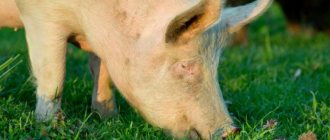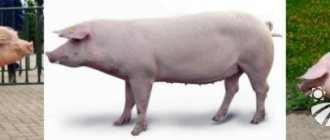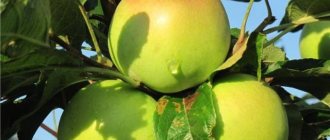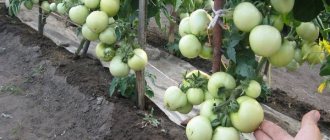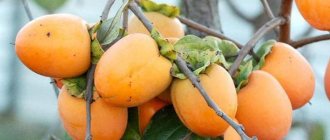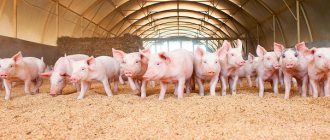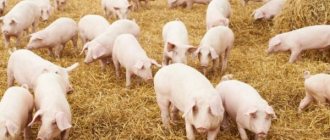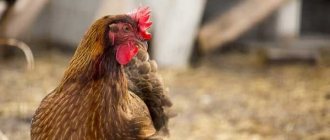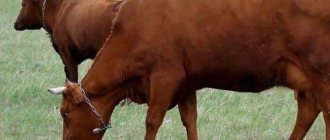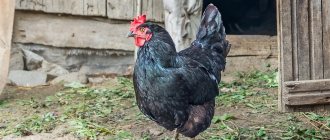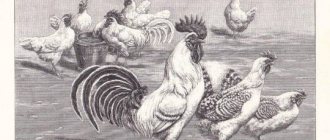Advantages of the breed:
- Excellent health: resistance to infectious diseases, cold, strong stomach.
- Unpretentiousness. Reduced requirements for housing conditions and feed.
- Fattening costs 3 times less than the average domestic meat breed.
- High productivity characteristics, not much inferior to officially recognized meat breeds.
- Rapid achievement of puberty. High fertility.
Disadvantages of the breed:
- The breed is new, its characteristics are not as well known and tested as those of the breeds included in the Register. Lots of rumors and speculation.
- This is a hybrid, so pig characteristics may vary. For example, one piglet from one uterus will gain 100 kg by 6 months, another - only 70 kg.
- Karmaly piglets are more expensive than Mangal or Korean piglets, and it is difficult to distinguish them from their ancestors by appearance, which is what cunning businessmen take advantage of, passing off familiar breeds as new. Advertisements for the sale of piglets are found everywhere: from the Nizhny Novgorod region to the Sverdlovsk region.
The only reliable way to get Karmaly piglets in your own backyard is to do the crossing yourself or personally know the breeder.
If you have reliable breeding material on hand, then the Karmaly breed will really please pig farmers. The effect of heterosis allows the hybrid to borrow the best from both ancestors.
Karmals develop quickly, like Vietnamese potbellies, and at the same time gain considerable weight, like Mangals. The excellent taste of the meat completely sweeps aside any hesitation. The new product is definitely worth attention, especially if you already have experience in breeding the original breeds.
Pigs of the Karmal breed. Characteristic
Karmaly pigs appeared as a result of crossing exotic breeds of pigs - Vietnamese and Korean.
The breeds belong to herbivores. In Karmals, 2/3 of the traits of the Mangalitsa (Vietnamese pot-bellied pig) predominate. The individual appearance of the animals prevents them from being confused with other pigs. They have fluffy, sometimes wavy, thick, dark-colored fur. The fur allows the animals to live outdoors all year round.
The hybrid species of pigs is divided by origin into two subspecies:
- Standard type. A hybrid of a wild boar and a pig, when the male is a Vietnamese pot-bellied breed, and the female is a Korean herbivore. The quality of hybrid pig meat is inferior to the royal subspecies.
- Royal type. A cross between a pig and a boar, where a Vietnamese breed sow is impregnated by a Korean herbivorous boar. The output is meat products of the highest quality.
The meat of herbivorous pigs has a special taste and aroma. Gourmets have long appreciated the dietary properties of dishes made from lean pork. Few layers of fat accumulate.
If Karmal piglets are overfed, they will form a thin layer of lard, which is easily separated from the meat.
To achieve slaughter weight, the Karmal pig is fed until 1.5 years of age, when it reaches a weight of 150-200 kg. The diet of adult karmals consists not only of grass. They happily eat food scraps and juicy vegetables. Depending on the composition of the feed, different taste qualities of the resulting pork are obtained:
- Adding dairy products (whey, skim milk) to the feed allows you to obtain the most tender meat products.
- Feeding predominantly grains and vegetables will reduce the palatability of the meat.
- Adding large amounts of fish waste to the feed will result in a fishy odor in the animal's meat.
- The use of low-calorie products (cake, soy, fishmeal) will lead to a decrease in the quality indicators of meat products.
If it is not possible to feed the karmals a balanced diet with a large amount of fresh feed, they use mixed feed. Complete replacement of succulent ingredients with compound feed negatively affects the growth of pigs and the quality of meat.
Even with balanced feeding, salt and chalk are added to the animals' food. These components help build a stable core and strengthen the legs.
In the summer, the pigs are provided with grazing on green grass or freshly cut grass is thrown into the pen. For the winter, it is better to stock up on juicy root vegetables, hay, and silage, which will replace vitamin supplements for animals.
Newborn Karmala piglets look unusual. Born from the same sow, they turn out to be multi-colored: black, brown, gray, two-colored, striped.
With age, some color features disappear (for example, stripes), but the main color remains. After slaughter, the skin becomes completely white.
Feeding
Feeding karmals does not cause any difficulties. The specificity of this hybrid breed is the exceptional functioning of the gastrointestinal tract, which allows it to cope with any type of feed.
In accordance with their age, young animals should be fed according to the following scheme:
| Piglet age | Diet |
| From birth to 7 days | Sow's milk |
| From 7 to 15 days | Green grass |
| Over 15 days | Transition to an adult diet |
Once the piglets reach two weeks of age, they can be switched to adult food. At the same time, new components should be introduced gradually, monitoring the baby’s condition.
It is advisable to add products in the following sequence:
- grated juicy vegetables - pumpkin, carrots, beets;
- boiled or steamed porridge;
- boiled potatoes - no earlier than 3 weeks;
- concentrated feed.
In addition to the basis of the diet - green grass (in winter - hay), piglets can be given crushed cereals, simple vegetables and fruits.
Advice! When raising young carmols, the use of special feed additives is not required - the piglets receive the required amount of nutrients from regular food.
Adult pocket
The unpretentiousness and omnivorous nature of karmals is a feature of this breed, making keeping pigs extremely simple and easy.
The diet of an adult pig may include:
- crushed grain;
- steamed porridge;
- unspoiled food waste;
- raw and boiled vegetables;
- acorns, apples.
Karmals give good weight gain even with the most unpretentious diet - meadow grass and crushed grain. Due to the presence of herbivorous pigs in the family tree, the presence of expensive components in the diet of karmals is unnecessary.
To obtain more juicy and flavorful meat, animals are given dairy products and juicy greens. Despite the undemandingness of pockets to the contents of the feeder, it is undesirable to use low-grade products when feeding - cake, fishmeal, soy.
The presence of such food in the diet will lead to a significant decrease in the consumer qualities of meat and the appearance of a characteristic taste.
If the owner cannot provide the karmal with a sufficient amount of natural food, cereals and greens, concentrated feed will come to his aid. At the same time, the principles of a balanced diet must be observed.
| Product type | Share in the daily diet, % |
| Compound feed | 70 |
| Raw vegetables | 20 |
| Bone meal or boiled fish | 5 |
| Bean flour, bran | 5 |
The best product for pockets is natural food. Concentrated feed should not exceed the specified norm and it is advisable to use them in winter, when it is not possible to make maximum use of natural products.
To compensate for the deficiency of mineral substances, it is recommended to give chalk and a small amount of table salt to karmals. In winter, you can use special vitamin feed additives.
Taste characteristics of meat and lard
Pork obtained after slaughtering karmal is close in taste to young tender veal. Thin and even layers of lard give the meat a marbling effect, which makes this product ideal for cooking bacon.
Karmalov meat contains virtually no fat and is low in calories.
The average energy and nutritional value of pork is as follows:
| Nutrient content | In grams per 100 g of meat |
| Carbohydrates | |
| Fats | 7,1 |
| Squirrels | 19,4 |
| Calorie content | 160 kilocalories |
| Vitamin composition | |
| D | 2.31 µg (23%) |
| B1 | 0.85 mg (56%) |
| B2 | 0.23 mg (13%) |
| B5 | 0.49 mg (10%) |
| B6 | 0.45 mg (23%) |
| B9 | 6 mcg (2%) |
| B12 | 0.82 mg (27%) |
| PP | 5.3 mcg (27%) |
Karmal meat makes perfect bacon
In addition to the high content of B-group vitamins, carmal meat can be called a record holder for the amount of vital minerals - selenium (26%) and zinc (16%) and essential amino acids. Thus, per 100 g of meat there are up to 44% valine, 66% histidine, 52% each tryptophan and threonine. This fact makes karmalov pork not only a delicacy, but also extremely beneficial for human health.
The surface fat layer of pockets is small; the fat is easily separated from a piece of meat. The skin is white in color and is characterized by thinness and softness. Due to the fact that pockets are not intended for long-term cultivation, the lard of young piglets remains plastic, melts well and has a pleasant taste and aroma.
Karmalov pork helps improve the health of the body due to its rich vitamin and mineral composition
Possible diseases
Despite their strong immunity, Karmals are still susceptible to diseases, and the breeder always needs to be on alert: identify the disease in time and begin its treatment. It is important to remember that at the slightest sign of infection, you will need the help of an experienced veterinarian. Do not self-medicate under any circumstances; be sure to consult a doctor.
Frequent ailments of the Karmals include mastitis or pneumonia. You can help protect your animals from this by taking precautions that can serve as disease prevention.
If you live in a harsh and frosty climate, then it is recommended to build dry and thick bedding for your pets. It will help Karmals survive the cold and provide them with reliable protection from frost. There should be no drafts in the room where animals live. In addition, it is necessary to regularly clean and disinfect the premises.
If, nevertheless, a representative of this breed becomes ill, the first thing to do is to place the sick animal in an isolated area. Then you need to call a veterinarian for an examination and a correct diagnosis. In addition, the doctor will prescribe all the medications necessary in this case. The owner should give all medications to the pet only as prescribed by the veterinarian.
The next thing to do is to inspect all pigs. This is done in order to find out if any other animal is infected. The pigsty in which the herd was housed undergoes prompt disinfection.
Origin of the breed, varieties of karmals
The Karmala pig breed is hybrid in nature. It was obtained by breeders by crossing Mangals, which have Hungarian roots, with Asian herbivorous pigs (which are also popularly called Vietnamese or Korean pot-bellied pigs). Depending on the methods of hybridization, there are 2 types of pockets:
- Simple. It is the first generation from pigs (parents) of two different breeds. In this case, the karmals inherit half of the characters from the Asian herbivorous artiodactyls and mangals.
- "Royal". Obtained through more complex crossing. The bred individuals end up with 75% of the characteristics of barbecues. At the first stage, a female and a male with Asian and Hungarian roots are crossed (as in obtaining a simple species). Then the resulting individuals are crossed with Mangal pigs. This is done to obtain a larger physique and delicacy properties of the meat.
Origin of Karmal pigs
Karmals were bred as a result of multi-stage crossing. After bringing together a female Mangalitsa and a wild boar, a hybrid was bred, which was subsequently mated with a boar from a herbivorous Korean pig. As a result of outbreeding, piglets were born that combine the endurance and protection from diseases of a natural boar, the unique appearance of a Hungarian barbecue and the incredible calmness of a true Asian.
Karmals owe their unique wool to barbecues
Karmals, depending on the order of crossing of different breeds, are divided into two types:
- ordinary;
- royal.
An ordinary karmal is produced as a result of the mating of a mangal and a Korean pot-bellied pig, while a royal one requires additional selection work. The hybrid obtained from the “marriage” of a Mangalitsa and a Korean boar is subsequently mated to a purebred Mangal. Royal karmals are distinguished by an intensive rate of fattening and the high properties of the resulting meat.
Karmals have the best qualities from their ancestors
Today it cannot be said that the main characteristics of the Karmal breed are fully formed, since breeders continue to work on improving these pigs.
How to choose a purebred pig
Before purchasing pockets from a pig farm or at a fair, you need to take a close look at the behavior of the animals. Piglets do not complain about their health, but it is quite possible to acquire an unhealthy baby
Therefore, please note that a healthy piglet:
- playful and always looking for food - nibbling grass, chewing feed;
- has wool that is pleasant to the touch;
- his snout is wet, not hot;
- is the owner of a dry ponytail that fits tightly to the body and does not come off;
- breathes smoothly, without wheezing or gurgling.
Please note the difference in weight. 3-week-old Korean piglets weigh the same as a newborn baby from Karmals
Therefore, you should not believe that in front of you is a karmal who runs quickly and eats grass, just after being born.
The purchase of pigs should be approached responsibly. Despite good health and high adaptation of pigs to all living conditions, there is a possibility of acquiring an unhealthy animal. To purchase healthy piglets, it is recommended to follow the following rules:
When choosing animals, you should carefully examine the tail - in a healthy pig it is covered with hair and does not adhere to the body. To prevent cunning sellers from fooling the buyer and selling him another breed instead of the Karmal, professionals recommend familiarizing yourself with photographs and biological characteristics of the animals in advance. When choosing piglets, pay attention to their breathing. They don’t buy pigs with wheezing - they have a disease of the respiratory system, with which they will not live long. Newborn piglets are covered with thick hair, so if a bald or semi-bald piglet is put up for sale, you should refuse to buy it. Karmalov is considered one of the popular meat breeds with a minimal fat layer
To minimize fatty fibers on meat, it is recommended to purchase the noisiest, most active piglets with powerful hooves and high legs. The activity of the animal will make its carcass more meaty
Karmalov are considered one of the popular meat breeds with a minimal fat layer. To minimize fatty fibers on meat, it is recommended to purchase the noisiest, most active piglets with powerful hooves and high legs. The activity of the animal will make its carcass more meaty.
You can find Karmal on farms, from private breeders, and on the Internet. The risk of buying a purebred breed is high, so the best option for obtaining a breed is considered to be cross-breeding pigs yourself.
If there is no desire or opportunity to do this, when purchasing, it is recommended to pay attention to the following indicators:
- The animal's tail should be dry and close to the body.
- Even a newborn piglet is not bald; there should be no bald spots on the thick, striped coat.
- A young animal should be active and fussy.
- The eyes sparkle and there is a quick reaction to what is happening.
What to do if piglets grow poorly
As a rule, farmers and breeders of karmals are satisfied with the growth and weight gain of their piglets. However, if a pig farmer still faces this problem, first of all he needs to reconsider the way he feeds his pigs. As already mentioned, for piglets to actively grow, their diet must be balanced and varied. With proper nutrition, young animals gain weight of 80-120 kg by 8 months.
If the piglet is not growing well due to lack of appetite, accompanied by any other painful symptoms (for example, lethargy, etc.), then the animal should be shown to a veterinarian (illnesses in karmala are rare).
The appearance of the Karmal breed, exterior and features
Representatives of the Karmals took the best qualities from their ancestors, while the disadvantages of one parent were offset by the advantages of the second. Unlike Mangalitsa, these pigs are more precocious and produce more offspring. They are distinguished from the Vietnamese by their stronger immunity, the ability to farrow without human help, and incredible frost resistance.
Karmals can grow up to 300 kg. This figure is achieved over a long period; usually individuals stop growing at a weight of 280 kg. But sows and boars that have been used for breeding for several years usually gain three hundredweight.
Since the Mangalitsa breed contains genes from wild pigs, these traits were passed on to the Karmals. A newborn piglet often has stripes characteristic of savages, but gradually they disappear. Adult Karmals become black, ash or brown. The hair of these pigs is thick, especially in winter, this is also a merit of the intervention of the Mangalitsa genes.
This precocity was obtained due to the influence of the blood of Vietnamese pot-bellied pigs. A standard litter consists of about 12 piglets, but many cases have been recorded when their number reached 20 piglets.
Karmals have rounded shapes. Their muzzle is of medium elongation, their ears are small and elastic. The legs are short, while the belly is quite tucked and does not hang out like pot-bellied pigs. The back, chest and sacrum are wide. This is especially striking against the background of a short body. The neck is thick and short, while the head appears small.
The advantages of the breed include:
- rapid weight gain;
- calm disposition;
- possibility of feeding on pasture;
- low percentage of fat content;
- strong immunity;
- high independence.
Karmals are kept on pastures or in pigsties with spacious walking areas. They are often released. When kept in a closed pigsty, the benefits of keeping them are lost. Pigs cannot find their own food and will have to carry everything themselves. Since grass and hay are low-calorie foods, you need a lot of it. As a result, there will be a lot of trampled waste on the floor of the pigsty that will have to be cleaned up.
As for the nature of animals, their behavior is influenced by their wild ancestors. They do not like to let people near them, especially strangers. Karmals will strive to move away from those who are trying to approach them, especially when kept for grazing.
At the same time, the animals are very calm, they do not try to start fights among themselves, chase, scream or dig the ground. Their behavior is characterized by accuracy in comparison with other breeds.
Karmals do not dig, and if the fenced paddock has weak defenses, then it is quite possible that the pigs will not pay attention to this, especially if they have enough food inside
What to feed pigs
Karmal hybrid pigs are unpretentious in food. In summer they can be free to graze all day. In the evening, feed with porridge or vegetables. These pigs can eat crushed grain, food waste and still gain weight well. In winter they are given hay and fodder or sugar beets and, of course, porridge. Pork feed can be used. In general, the owners don’t really bother with what to feed the pigs. Fattening pigs of this type is several times cheaper than traditional breeds.
During any fattening, even the most intensive, Karmal pigs do not form a thick layer of fat. The maximum is a small layer of subcutaneous fat. Karmaly is a breed of pig that is valued for the high taste of its meat. It is tender, juicy, non-greasy, in general, a real delicacy.
These incredibly charming animals are endowed with a calm character and a lack of desire to misbehave. It’s hard to imagine Karmal digging a tunnel or breaking a fence. He will calmly graze in the paddock, happily eating grass, porridge or vegetables.
General characteristics of the breed
Karmaly pigs are a mixture of Vietnamese pot-bellied and Korean herbivorous pigs. Karmals have a rather exotic appearance. They are quite difficult to confuse with other breeds. These pigs have thick, curly fur. This allows them to spend time outdoors all year round. Newborn piglets gain weight quite quickly and reach sexual maturity by the age of four months. In the blood of Karmal pigs, three quarters contain the blood of Mangals and one quarter the blood of Korean pigs.
General external signs and photos of Karmal breed pigs
Karmals, unlike the ordinary pigs we are used to, wear fluffy and sometimes even wavy fur coats. The color of the little piglets is very interesting. Babies born from the same sow can each have a different color. One may be black, another gray, a third brown, a fourth striped, and a fifth bicolor. Over time, the stripes disappear, and mature piglets become ashen, brown or black. Karmalov's crazy skin will be perfectly clean and white.
Pig Karmal photo
Karmalov breeding zones
Due to the fact that Karmals are not afraid of cold weather and are endowed with excellent immunity, they are kept in almost all domestic regions. In addition, breeding Karmals are purchased by farms to improve the qualities of local breeds.
Productivity
Meat
Legends can be made about Karmalov meat. Gourmets who taste dishes made from the meat of this breed of pig note its extraordinary juiciness and leanness. It is tender and very fragrant. Many people say that Karmalov’s meat contains notes characteristic of veal. The presence of lard in the meat of these pigs is minimal. If it happens that the animal has fattened up a thick layer of fat, then it can be very easily cut off and turned into lard.
Fertility
Karmals demonstrate excellent performance in terms of fertility. By the age of eight months, a pig can not only mate, but also piglet. During farrowing, the uterus does not need outside help and copes with its task absolutely perfectly. Newborn babies, the number of which can reach twenty-one individuals, receive a decent amount of milk and gain weight wonderfully. After a year, the pig weighs about a hundredweight, and after another six months it is able to double this weight. Farmers are also pleased with the fact that a month-old pig can already be weaned from its mother and switched first to grass, and then to porridge. At the same time, the uterus is again ready for mating.
Salo
Since Karmaly belongs to the meat category, lard is not their strong point. A thin layer of fat is more likely a way to make the meat more juicy than fatty.
Description of the Karmal pig breed
How the breed was developed
Karmal is an interbreed hybrid obtained by crossing Mangalitsa with Korean herbivorous pigs. In the direction, there are two methods of breeding, as a result of which either the royal subspecies or the standard one are born. This depends on the parent pairs involved in the breeding process.
Standard karmals are obtained by mating a Korean sow with a boar of the Vietnamese breed. The offspring are born piglets that inherit qualities in a 50% ratio from each parent. The heterotic effect is rapid growth, but at the same time the taste of meat products is completely indistinguishable from meat of other breeds in pig farming.
To obtain the royal pocket, another type of crossing is used. The parents are taken from the same breeds as for the standard ones, and then the hybrid females are mated with sires of the Vietnamese breed, and the offspring receive 75% Vietnamese blood. The royal variety is one step above the standard one, especially in the taste of the resulting meat. The products are considered delicacies and have a high cost.
Hybrids are characterized exclusively positively. The animals have no aggression, they do not fight among themselves, and also do not pester the animals living in the yard. Karmals treat people very well and recognize their owner.
Pig pocket
Productivity
Hybrid sows are characterized by rapid puberty. Like Asian pigs, they reach sexual maturity as early as 4 months. It is better to carry out the first mating no earlier than 6 months. Karmals also have good fertility, especially compared to the low-fertility of the Hungarian Mangalitsa. Usually karmals give birth to 8-10 piglets.
The reason for the appearance and high cost of hybrids is the effect of heterosis. But this feature does not manifest itself as usual. In livestock farming, hybrids weigh more than their parents, and such crosses are more profitable to raise for meat. But a Vietnamese/Korean pig only grows up to 150, and a barbecue up to 300 kg. The hybrid has intermediate sizes. An adult animal weighs 220 kg.
There seems to be no particular benefit in growing karmal. But the benefit here is not in size. The grill has a bad taste of meat - a legacy of wild boar. At the same time, he inherited marbled meat from Mangalitsa. And Vietnamese and Korean pigs have high quality meat, but lack marbling. When crossed, a large amount of tasty marbled meat is obtained.
How to breed karmals?
Pigs of this breed become sexually mature early. At the age of three and a half months they reach maturity, and at eight months they can already have offspring. Karmals are very productive. Their offspring ranges from twelve to twenty-two individuals. After the piglets reach thirty days of age, the female can mate again.
Karmal pigs can produce offspring as early as 8 months
The female bearing the offspring will not require assistance during childbirth. There is also no need to care for newborn piglets because female karmals are caring mothers. The only thing that needs to be provided for little piglets is a small barn with an enclosure. The image below is an example of a good “house” for small and adult pockets.
The photo shows a pig barn with a walking area
Small pockets are very beautiful. They can be either monocolored, like adults, or with stripes that are located along the body. Multi-colored piglets are often found. After some time, not a trace remains of the stripes, since the color of mature pockets becomes monochromatic.
There are no difficulties in the process of feeding small pockets. The table shows the age categories of piglets and their corresponding diets.
| 0-7 days | mother's milk |
| 7-14 days | soft grass |
| 14 days | adult food |
Small piglets should be introduced to adult food gradually. To prevent them from having health problems, you should start with juicy and soft food. Soft grated vegetables, for example, pumpkin, beets and carrots, can play its role. It is better to use boiled potatoes as food after the small potatoes reach twenty days of age.
The diet of small piglets needs to be balanced according to a certain pattern. Here are the products needed for them and their percentages:
- concentrated feed - seventy percent;
- soft vegetables - twenty percent;
- fish with soft bones or bone meal - five percent;
- bean flour - five percent.
It is not necessary to use special additives. Karmals grow well even without stimulants.
Piglets of the Karmal breed - photo
Growing and breeding karmals
The young offspring of Karmals are unpretentious in care; from birth the piglets are in good health.
Karmal sows can have offspring from 4 months , and are ready for re-fertilization after 4-5 months. At one time, a pig can give birth to up to 20 piglets. Childbirth and farrowing occur without the participation of the owner. The genetic feature of the breed is that more females are born in the offspring.
The boar reaches puberty a month later; one male is enough to fertilize all the females in the herd. To improve the characteristics of the breed, it can be mated with other species.
The young offspring of Karmals are unpretentious in care; from birth the piglets are in good health . After reaching puberty, pigs are regularly vaccinated and anthelmintic treated.
Description of the breed
This type of pig is a hybrid. He acts as a mixture of Vietnamese potbellied and Korean herbivorous pig breeds. Depending on their origin, there are two types of pockets:
- standard
- royal
The standard breed is obtained by crossing a male Vietnamese potbelly and a female Korean herbivore breed. They are a little cheaper, but inferior to other types in terms of the taste of meat.
Royal Karmals are obtained by crossing a female Mangalitsa and a Korean herbivorous male. An important condition is the purebred female. In this case, this type will have an excellent taste of meat.
Royal pockets.
When crossed, the qualities of the Vietnamese pot-bellied breed predominate in the pigs. In percentage terms, Karmals are three-quarters Mangals and one-quarter Korean herbivores.
The usual weight of a one and a half year old pig is 150 - 200 kilograms. A feature of the breed is the pigs' thick hair. Hair sometimes has a wavy shape. The coat color is predominantly black and ash-gray, but can also be chestnut. Most piglets have a soft pink skin color, while karmals have white skin.
These pigs are in good health. So, buying healthy piglets of the Karmal breed will not be difficult. In exceptional cases, there is a risk of buying an unhealthy piglet. To avoid this you need to follow some recommendations:
The health of little pigs is determined by the condition of their tail. It should be dry, not shabby, and under no circumstances should it lie close to the body; If possible, you should listen to how the piglets breathe. Wheezing may indicate diseased lungs
Such animals will not live long; It is worth paying attention to the hairline. If a pig's pockets peel, this is a sign of poor health, and purchasing such a pig is not recommended.
Karma piglets.
When buying piglets, in addition to problems with their health, you may encounter elementary deception. Unscrupulous sellers can sell simple Korean pigs under the guise of karmals. Knowing some of the nuances, it’s easy to expose them. Small, newly born pockets are the same in weight as Korean piglets at three weeks of age. Therefore, if you are offered a barely born individual with adult habits, you should think about buying.
The breed of these pigs is distinguished by the minimum size of the fat layer. If you want to further reduce the amount of fat, you need to choose the noisiest and shrillest pig; the more active the animal, the less fat it has. Fussy habits are also signs of excellent health.
Karma piglets: characteristics and description of appearance
Karmal piglets Piglets
of the Karmal breed can adopt the appearance of a barbecue or a Vietnamese pot-bellied pig , and therefore the breeds are easy to confuse. Individuals come in different colors, a distinctive feature is the presence of stripes. With age, the color evens out. The head of the Karmal is small in comparison with the body, the chest is wide, the body is massive, the legs and ears are small, and the fur is thick.
The character of the animal is also unpredictable. The pig can be calm or adopt the habits of a wild boar. Hybrid origin also affects productivity: piglets from the same litter can gain weight differently.
Breed productivity indicators
By the 2nd month of life, young animals grow up to 60 cm in length and weigh 16-20 kg; by 12 months of age, the weight of piglets reaches 100 kg or more; by 18 months, males weigh about 160 kg.
With intensive fattening at 3 years, the weight of an individual reaches 300 kg.
The amount of meat at slaughter is 80-85% of live weight; in terms of taste, it is similar to veal. The low fat content and its uniform layers make it possible to make bacon from the meat. The costs of maintaining young animals pay off in the first year due to their ease of care.
Be sure to read:
Meat breeds of pigs, their features and characteristics
Features of care
As mentioned above, karmals are not finicky animals; this was partly influenced by the presence of wild boars in the pedigree. This also applies to conditions of detention. Animals do not require the construction of a special pigsty and its insulation. They will feel great outdoors in a fenced area. Even small piglets, from about 2 months of age, will be able to stay comfortably in the pen. In addition, you should not develop an area that is too large; young animals only need a small enclosure, which can be expanded as the individuals grow older. Karmals are herd animals, they stick together and have a leader. This is very convenient when handling pigs; for example, if you need to drive them into a room, you can simply send the leader there. The rest of the herd will follow him.
If an open pen is chosen for keeping pigs, care must be taken to arrange feeders and containers that will contain drinking water. If we are talking about the summer period, animals will happily eat pasture, feasting with appetite on raw vegetables and herbs.
Karmals are very clean. This needs to be taken into account, so experts recommend installing a container in the pen where they can take water treatments.
If you have decided to purchase young piglets, you need to take care of their initial location. A small shed will do just fine. To prevent very small animals from getting sick, you should ensure that there are no drafts in the room. It should also be fairly dry. If the animals were purchased in the summer, it would not hurt to have a small enclosure built near the barn, where they can graze and be in the fresh air. After 6-8 weeks, the pigs can be released to free grazing.
There are subtleties in purchasing Karmal piglets. You can identify a real purebred and healthy piglet by certain characteristics.
- Piglets of this breed are never bald. Even newborns are covered with fur, which lies in smooth waves. Often young individuals have stripes on the back and sides. Any bald spots indicate that the animal may be unhealthy.
- The tails of carmals are dry, they do not adhere to the body. The legs are long and strong, the eyes are shiny and react perfectly to what is happening around, and the animal itself is very mobile. These indicators indicate that in front of you is a completely healthy and well-developing piglet.
- Despite a very strong immune system, sometimes karmals can get sick. At risk, for example, are mastitis and pneumonia. Preventive measures, which turn out to be quite effective, will help you avoid this trouble. If the region has fairly harsh and frosty winters, it would be a good idea to build deep and dry bedding for the pigs; it will provide additional protection from the cold. The room in which the pockets are kept should not be subject to drafts. It is necessary to ensure its cleanliness and timely disinfection.
Content
Once purchased, the piglets should be placed in a small barn. They will remain there until they reach the age of 1.5-2 months, when they can be released into the wild.
To protect young pigs from diseases, it is advisable to ensure that the room is dry and completely free of drafts.
In the warm season, you can build a small enclosure next to the pigsty so that the piglets can graze in the open air during the day.
The presence of wild pigs in the pedigree of wild pigs largely determines the conditions for keeping representatives of the hybrid breed - it is not necessary for them to have a separate pigsty, since they feel best in an open-air pen.
Starting from the age of two months, piglets enjoy being in a herd grazing in a fenced area.
At the same time, they do not require a large space - young animals can easily tolerate being kept in enclosures; when they grow up, a small area surrounded by a metal mesh or wooden slats around the perimeter is sufficient.
Karmals have a well-developed sense of family - they prefer to stay surrounded by their relatives, intuitively choosing the leader of the herd.
In order to drive the pigs into the room, it is enough to send the leader there - and the piglets will calmly follow him. In an open pen, it is advisable to place water containers and feeders, although in the summer, carmals are able to feed on pasture - field grass and raw vegetables.
Piglets are clean animals, so they need to be provided with a bathing tank.
Interesting! To protect young karmals from diseases, recycled automobile oil is used, which is added to the bathing container for piglets.
The myth of lard
When advertising hybrids, sellers often claim that these pigs have a thin layer of fat that is easily separated from the meat. In fact, there is not a single prerequisite for such a phenomenon. In Asia, lard is valued, not pig meat. Therefore, all Asian breeds gain subcutaneous fat well. Even 4-month-old Vietnamese piglets, with normal feeding, manage to gain 2 cm of bacon on the backbone. And this lard is very difficult to separate from meat. It has to be cut off.
The Hungarian Mangalica was also originally bred for lard. The marbled meat turned out to be a pleasant surprise. In a couple of autumn months, a wild boar is able to fatten up a supply of fat on acorns for the entire winter. Mangal is a hybrid of mangalitsa and wild boar.
Karmal has nowhere to “get” the easily separated thin layer of lard. All its ancestors are distinguished by good salting and a thick layer of bacon. The main advantage of the hybrid - gaining 200 kg of live weight already in 12 months - is explained by the ability to quickly increase fat. So the pocket cannot have any thin layer.
Origin information
Let's start with the fact that the idea of Karmal pigs exists exclusively in the Russian-speaking space (in Russia, Belarus and Ukraine). The use of the word “breed” in this case cannot be considered adequate, since we are talking about animals that are the direct result of interbreeding, that is, hybrids, and for such offspring there are no clearly defined standards. In the case of Karmals, there is no unambiguous information about the breeds involved in crossing. The reasons lie in both the confusing terminology and the spontaneous nature of the “work of breeding” a new variety of pigs.
Among the original breeds, the crossing of which led to the creation of karmals, are Vietnamese pot-bellied pigs (pictured on the left) and Hungarian downy mangalitsa (right)
There are two versions of the origin of the hybrids in question. According to the first of them, the parents of karmals are considered to be Korean herbivorous and Vietnamese pot-bellied pigs, and according to the second, one of these breeds and the Hungarian Mangalitsa. It is impossible to understand which of these options is more truthful for the following reasons:
- Korean pot-bellied and Vietnamese pot-bellied herbivores are very close breeds (these are varieties of Asian pot-bellied herbivores). At the same time, few purebred “Asians”, once brought to our country, are bred. Most farmsteads tend to keep crosses of these two varieties. The descendants of the resulting “mestizo” have very different characteristics, which, however, do not correspond to advertising descriptions of the qualities of karmals;
- Personal and farm households often contain a wide variety of crosses between Asian and European breeds. Such pigs are also called either “Vietnamese” or “Korean”. It is very difficult to understand which of them can be the parents of hybrid piglets;
- For some reason, many domestic livestock breeders call “barbecues” not male pigs of the Mangalitsa breed, but the descendants of the Vietnamese pot-bellied pig, which introduces additional confusion into the descriptions of the parents of hybrids.
Most likely, the parents of the piglets that are sold in our country under the name “ordinary karmals” are female Asian pot-bellied herbivorous pigs (that is, one of its varieties that is available on the seller’s farm) and male Hungarian Mangalitsa.
In addition to the usual pockets, some breeders also offer individuals of the “royal” variety
In addition, they also sell the so-called royal karmals - varieties that, judging by the advertising, were obtained from “regular” females after mating with barbecues. None of the trustworthy breeding farms is involved in the breeding and sale of pigs of the “breed” in question. This means that it is not possible to obtain true information about the origin of hybrids.
Karmaly breed of pigs
First of all, it should be mentioned that the Karmal pig breed is a hybrid, as it was bred through multi-stage crossing. The result was a high-quality meat breed that combines the best qualities of Vietnamese pot-bellied and Korean herbivores (Figure 1).
Figure 1. Exterior of pockets
However, modern karmals are usually divided into two types: regular and royal. Belonging to one species or another directly depends on the animals that were used for breeding work.
Breed Features
The main feature of the breed is its unusual appearance, which makes it absolutely impossible to confuse Karmals with other pigs.
Among the key features of pockets are:
- The animals' bodies are covered with thick curly hair, thanks to which they can stay in the fresh air all year round.
- Pigs are distinguished by strong immunity and have amazing resistance to typical livestock diseases.
- Newborn piglets rapidly gain weight and quickly reach sexual maturity.
In addition, these animals have an extremely calm nature. They do not misbehave or dig holes in the area, but calmly search for pasture in a fenced enclosure. Also, karmals are not prone to aggression and are quite peaceful towards both humans and their relatives. Moreover, during grazing, they prefer to walk not alone, but as a whole herd.
Another important feature of karmals is their ability to quickly gain weight, although they remain extremely unpretentious in food and maintenance. It should also be noted that the females are extremely fertile
In one farrow they can produce from 15 to 22 cubs, and almost all of them survive due to the well-developed maternal instinct of females. It is noteworthy that the female will be ready to mate again just four weeks after the previous farrowing, which makes breeding such animals economically profitable.
But the main feature of Karmaly pigs is their high meat productivity. Animals reach slaughter weight at the age of one and a half years, and the average body weight of an individual at this age can reach 220 kg, while the yield of clean meat from one individual is about 185 kg.
Appearance of pigs
In the previous section, we already mentioned that pigs of this breed have a very unusual appearance due to their thick hair. Experienced livestock breeders note that the appearance of karmals is similar to wild pigs. The only difference is that the fur of domestic animals is slightly shorter and curled into dense curls (Figure 2).
Figure 2. External features of the breed
In addition, Karmals can be distinguished from other breeds by their small and light head with short ears, but a massive and short neck. The animals' legs are also short, although the back and chest are wide. The hair of pigs is very thick, and another distinctive feature is the elongated snout and well-developed hip part.
Newborn piglets also look very unusual due to their original beautiful color. Interestingly, cubs born from the same sow can differ significantly from each other in color. For example, in one litter there may be a two-color, striped, gray, brown and black piglet. However, as animals grow older, all the stripes on the body of the animals disappear, and their fur acquires a uniform black, brown or ash color, although the skin remains white and clean even after slaughter.
Meat quality
Young animals grow slower than others - they gain weight suitable for slaughter only by one and a half years. The meat of Karmal pigs is highly prized. The amount of lard is small and located in thin layers. The yield of clean meat from each carcass is at least 85%. This is a very good indicator for pork.
The greasiness of the carcass greatly depends on the presence of vegetables and grass in the diet, subject to free range. Pigs raised in close quarters will have a higher percentage of fat in their meat.
Farmers who specialize in raising Karmal pigs believe that caring for them does not require special knowledge or high expenses. Pigs are calm, not aggressive and have a good appetite. Animals spend most of their time outdoors, which reduces cleaning costs.
If you have your own vegetables and pasture, the cost of fattening pigs is low, so the business is considered quite profitable.
According to reviews from Karmal owners, this breed is overly praised. Among the disadvantages, pig farmers noted poor weight gain with excellent nutrition and digestive problems after introducing crushed grains into the diet. In general, the Karmala pig breed is interesting, promising, and the quality of the meat is excellent.
Reviews
Dmitry Kolopenyuk, Samara
I read a lot of reviews about the Karmal pig breed. They were praised as very unpretentious animals, requiring almost no expenses for feed and a pigsty. I tried to find it, but it turned out to be not a breed, but a crossbreed. Moreover, there is no guarantee that they will sell you exactly the desired crossbreed, and not any other piglet under the guise of Karmal. If you want to be sure that you have the right cross, buy the original breeds and cross them yourself. I still bought a couple of Karmals. Or not Karmalov. In general, the piglets really turned out to be different. One grew very quickly, by 6 months he gained 100 kg. The second in six months was only 70 kg. In general, I did not see much difference with the Great White breed.
Oleg Alekseev, Chernigov
They tried to separate the Karmalovs. The piglets were taken from a trusted seller who had both barbecues and Vietnamese ones. But the offspring really turned out to be very different. Some are closer to Vietnamese, the other to Grills. We took from different litters. We tried to cross them with each other. The result... we won't do this again. It makes sense to breed Karmalov in the first generation.
